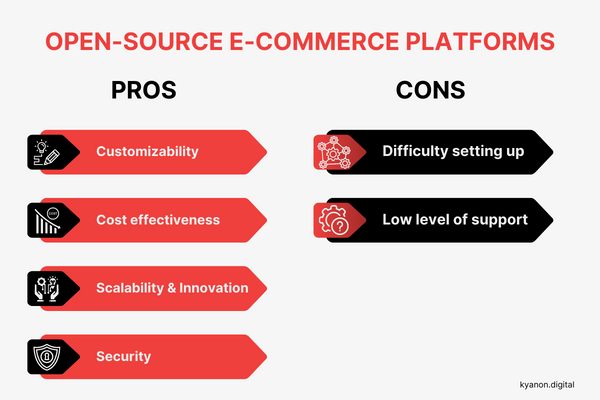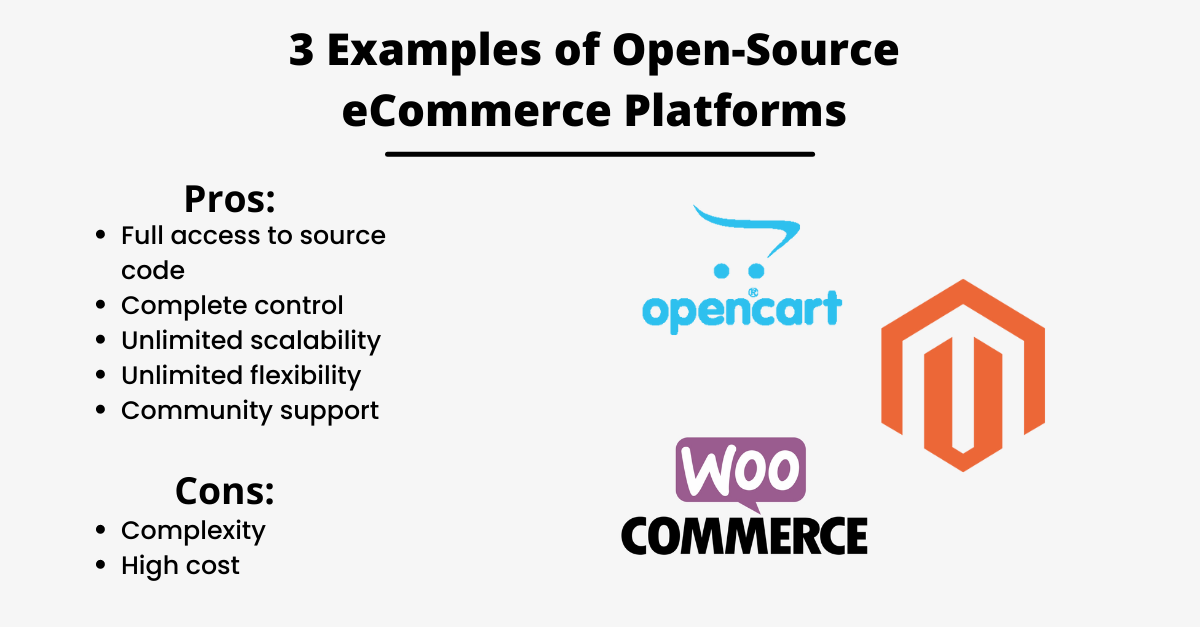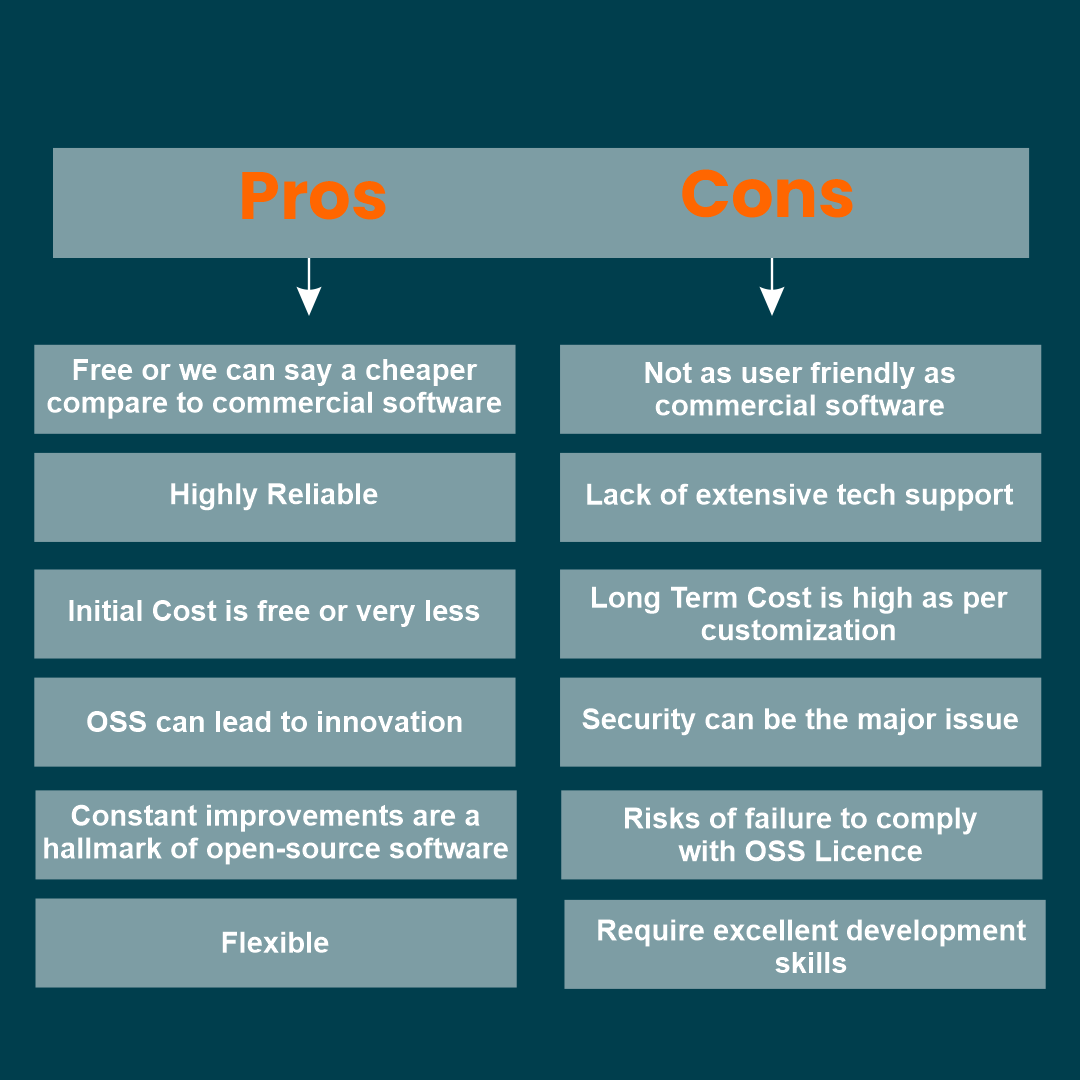Open-source e-commerce platforms are popular among businesses. They offer flexibility and control.
In the world of online selling, open-source e-commerce platforms have become a go-to option for many entrepreneurs. These platforms provide the freedom to customize and adapt your online store to your needs. But, like any technology, they come with their own set of advantages and challenges.
Understanding the pros and cons of these platforms can help you make an informed decision for your business. This blog will walk you through the key benefits and drawbacks, giving you a clear picture of what to expect. Whether you are starting a new online store or considering a switch, this guide will be helpful.
Introduction To Open-source E-commerce
Open-source e-commerce platforms offer flexibility and customization. They can be cost-effective but may require technical expertise. Users enjoy control over their store but might face security concerns.
Open-source e-commerce platforms are gaining popularity. They offer flexibility and control. Many businesses prefer these platforms over proprietary solutions. Let’s explore their pros and cons.Definition And Importance
Open-source e-commerce platforms have publicly accessible source code. Anyone can modify and distribute the software. This flexibility allows businesses to tailor their online stores. Customization meets specific needs and preferences. These platforms are often free. They lower the barrier to entry for new businesses. Companies can save money on licensing fees. They allocate resources to other important areas.Current Market Trends
The market for open-source e-commerce platforms is growing. More businesses are choosing these flexible solutions. They want control over their online presence. Popular platforms include Magento, WooCommerce, and OpenCart. Each offers unique features and benefits. Businesses select the platform that fits their needs. Security is a major concern. Open-source platforms are regularly updated. The community actively works on improvements. This helps keep online stores secure. In summary, open-source e-commerce platforms offer flexibility. They cater to various business needs. Their popularity continues to rise in the market. “`
Credit: kyanon.digital
Popular Open-source E-commerce Platforms
When diving into the world of e-commerce, choosing the right platform can be a game-changer. Open-source e-commerce platforms are a popular choice for many businesses due to their flexibility and cost-effectiveness. In this section, we’ll explore some of the most popular open-source e-commerce platforms: Magento, WooCommerce, PrestaShop, and OpenCart. Each of these platforms has its own unique set of features, advantages, and drawbacks. Let’s dig in!
Magento
Magento is a powerful open-source e-commerce platform known for its flexibility and scalability. It’s a great choice for larger businesses with complex needs. Here are some key points:
- Pros:
- Highly customizable
- Strong community support
- Advanced SEO features
- Handles large product catalogs
- Cons:
- Steep learning curve
- Requires significant server resources
- Can be costly to maintain
Woocommerce
WooCommerce is a plugin for WordPress that turns your website into a fully functional e-commerce store. It’s perfect for small to medium-sized businesses. Here’s why:
- Pros:
- Easy to set up
- Highly customizable with WordPress themes
- Large plugin marketplace
- Strong community support
- Cons:
- Can become slow with too many plugins
- Requires regular updates
- May need additional plugins for advanced features
Prestashop
PrestaShop is another popular open-source platform that is user-friendly and highly customizable. It’s great for those who want a balance between ease of use and advanced features.
- Pros:
- Intuitive interface
- Strong community support
- Highly customizable
- Multi-language and multi-currency support
- Cons:
- Can be resource-intensive
- Requires technical knowledge for advanced customization
- Modules can be expensive
Opencart
OpenCart is a lightweight and easy-to-use platform that’s ideal for small to medium-sized businesses. It offers a good balance of functionality and simplicity.
- Pros:
- Easy to install and use
- Lightweight and fast
- Good range of extensions
- Strong community support
- Cons:
- Not as feature-rich as other platforms
- Customization can be limited
- Requires additional extensions for advanced features
Advantages Of Open-source E-commerce
Open-source e-commerce platforms offer many benefits. They are a popular choice for businesses looking to set up an online store. Let’s explore some key advantages of using open-source e-commerce platforms.
Cost-effectiveness
Open-source e-commerce platforms are usually free to use. You do not have to pay for licenses. This can save you a lot of money. You only need to pay for hosting and maintenance. This makes it a budget-friendly option.
Open-source platforms offer great customization. You can modify the code to meet your needs. This allows you to create a unique store. You can add features that are important to your business. The flexibility is unmatched.
Community Support
Open-source platforms have large user communities. You can find help easily. There are forums and groups where users share solutions. You can also find a lot of tutorials. This makes it easy to solve any issues you may face.
Security And Transparency
Open-source platforms offer transparency. You can inspect the code for vulnerabilities. Many developers constantly check and improve the code. This makes it secure. You can trust the platform’s security measures.

Credit: www.mageants.com
Disadvantages Of Open-source E-commerce
Open-source e-commerce platforms are like a double-edged sword. They offer a lot of freedom and customization, but they come with their own set of challenges. Let’s dive into the disadvantages of open-source e-commerce to help you decide if it’s the right choice for your online store.
Technical Expertise Required
One major downside of open-source e-commerce platforms is that they demand a certain level of technical know-how. If you’re not tech-savvy, you might find yourself in a pickle. You’ll need to understand coding languages like HTML, CSS, and PHP. Without this knowledge, making the simplest of changes can feel like climbing Mount Everest. Hiring a developer can help, but that adds to your costs.
Maintenance And Updates
Another drawback is the ongoing maintenance and updates. Unlike hosted solutions where updates are automatic, with open-source, you’re on your own. You need to keep everything up-to-date to avoid security vulnerabilities. Regular updates can be a bit of a hassle, especially if they cause compatibility issues with existing plugins or themes. It’s like fixing a car; if you don’t keep it in good shape, it’s bound to break down.
Scalability Issues
Scaling your business can be tricky with open-source platforms. While they offer great flexibility, they can struggle under heavy traffic and large inventories. It’s like trying to fit an elephant into a Mini Cooper. To handle growth, you might need to invest in better hosting solutions and more robust server configurations, which can be costly and complex.
Limited Official Support
Lastly, there’s the issue of limited official support. Open-source platforms often rely on community support, which can be hit or miss. You might find yourself sifting through forums for hours, trying to solve a problem. Unlike proprietary platforms that offer dedicated customer service, with open-source, you’re mostly on your own. It’s like being in a foreign country without a map; getting lost is easy.
In summary, while open-source e-commerce platforms offer customization and flexibility, they also require technical expertise, consistent maintenance, and can have scalability issues, along with limited official support. Weigh these disadvantages carefully before making your decision.
Cost Considerations
When it comes to choosing an open-source e-commerce platform, the cost is a major factor to consider. While open-source options are often touted as being “free,” the reality is a bit more nuanced. Let’s dive into the cost considerations, breaking them down into initial setup costs, ongoing maintenance costs, and additional expenses. Understanding these aspects can help you make a more informed decision and plan your budget accordingly.
Initial Setup Costs
At first glance, open-source e-commerce platforms may seem like a no-brainer due to their zero-dollar price tag. However, setting up your online store isn’t entirely free. You’ll need to factor in:
- Domain Name: This is your website’s address and usually costs around $10-$15 per year.
- Hosting: Hosting services are necessary to make your website accessible on the internet. Prices can range from $5 to $50 per month depending on the provider and the features you need.
- SSL Certificate: Ensuring your site is secure is crucial. SSL certificates can cost between $10 and $200 annually.
- Design and Development: Unless you’re a tech whiz, you might need to hire a developer for customization. This can be a one-time fee or an hourly rate, adding up to several hundred or even thousands of dollars.
Ongoing Maintenance Costs
Once your store is up and running, the spending doesn’t stop there. Regular maintenance is crucial for a smooth operation and to keep your site secure. Ongoing costs include:
- Software Updates: Open-source platforms require regular updates for security patches and new features. While the software itself might be free, implementing these updates could require technical assistance.
- Security: Keeping your site secure is an ongoing task. You may need to invest in security plugins or services to protect against cyber threats.
- Technical Support: Unlike proprietary software, open-source platforms usually don’t come with dedicated support. You might need to hire a developer for troubleshooting and maintenance tasks.
Additional Expenses
Beyond the obvious costs, there are other expenses that might catch you off guard. These can include:
- Extensions and Plugins: To add specific functionalities to your site, you might need to purchase premium plugins or extensions, which can range from a few dollars to hundreds.
- Marketing and SEO Tools: To drive traffic to your store, investing in marketing tools and SEO services is essential. This can be a recurring expense.
- Payment Gateway Fees: Payment processors charge fees for each transaction, which can add up over time. Make sure to compare rates to find the best deal.
As you can see, while open-source e-commerce platforms offer the allure of being free, the costs can add up. It’s essential to evaluate all these aspects to ensure you’re fully prepared financially.
Customization And Flexibility
Open-source e-commerce platforms offer a great deal of customization and flexibility. These features attract many online store owners. You can mold these platforms to fit your unique needs. Let’s explore some key aspects of customization and flexibility.
Design And Functionality
With open-source platforms, you have full control over the design. You can create a unique look for your store. These platforms allow you to tweak every detail. From layout to color schemes, the possibilities are endless. Functionality is also customizable. You can add or remove features based on your requirements. Your store can be as simple or as complex as you want.
Third-party Integrations
Open-source platforms support many third-party integrations. These integrations enhance your store’s functionality. You can connect with various payment gateways, shipping providers, and marketing tools. Adding these tools helps improve your store’s operations. It also offers a better shopping experience for your customers.
Scalability Options
Scalability is crucial for growing businesses. Open-source platforms offer excellent scalability options. You can start small and expand as your business grows. These platforms allow you to add more products and features over time. You can also handle increased traffic without compromising performance. This flexibility ensures your store can grow with your business.
Security And Compliance
Open-source e-commerce platforms offer flexibility and customization. They do come with security and compliance considerations. Ensuring the safety and legality of your online store is crucial. Let’s break down the security and compliance aspects into three key areas.
Vulnerability Management
Open-source platforms are accessible to everyone. This means many eyes on the code. It can be a double-edged sword. On one hand, bugs and vulnerabilities can be identified quickly. On the other, malicious users can also find and exploit weaknesses.
Regular updates and patches are essential. Staying active in the platform’s community helps. Participating in forums and groups can keep you informed. Always apply security updates as soon as they are released. Keep an eye on the latest threats and vulnerabilities.
Data Protection
Protecting customer data is a top priority. Open-source platforms offer various tools and plugins. These can enhance data security. Implementing strong encryption methods is important. This ensures that sensitive data remains secure.
Use secure payment gateways to safeguard financial transactions. Regularly back up your data. This minimizes the risk of data loss. Educate your staff on data protection practices. Awareness reduces the chances of accidental data breaches.
Regulatory Compliance
Compliance with laws and regulations is vital. Open-source platforms may not provide built-in compliance features. It is up to you to ensure your store meets legal requirements. This includes GDPR, CCPA, and other privacy laws.
Familiarize yourself with the regulations that apply to your business. Use plugins and tools that help with compliance. These can automate some of the processes. Keep detailed records of compliance efforts. This documentation can be useful during audits.
Decision-making Factors
Choosing an open-source e-commerce platform involves weighing various decision-making factors. This section explores key aspects that influence your choice. Understanding these factors helps in selecting the best platform for your business.
Business Size And Needs
The size of your business significantly affects your platform choice. Small businesses may prefer simple solutions. These are easier to manage and require less technical know-how. Large businesses often need more advanced features. These include scalability and customization options. Assess your current needs and future growth plans.
Technical Resources
Technical resources are crucial for managing open-source platforms. They often need more setup and maintenance. You may need a dedicated IT team. Small businesses with limited tech resources might struggle. Evaluate your team’s technical skills and readiness. Consider whether you need to hire external help.
Long-term Goals
Your long-term goals should guide your platform choice. Think about where you see your business in five years. Open-source platforms offer flexibility and growth potential. They allow for extensive customization. This is ideal for businesses with evolving needs. Make sure the platform aligns with your future vision.
Conclusion And Recommendations
After exploring the pros and cons of open-source e-commerce platforms, it’s time to wrap things up and provide some actionable recommendations. This section will help you decide if an open-source platform is the right choice for your business. Let’s dive into the key takeaways, final thoughts, and next steps.
Summary Of Key Points
Here’s a quick recap of the main points discussed:
- Flexibility: Open-source platforms allow for extensive customization, enabling businesses to tailor their online stores to their specific needs.
- Cost-Effective: These platforms are often free to use, reducing initial setup costs. However, costs may arise from hosting, maintenance, and development.
- Community Support: A large community of developers and users can provide support and contribute to the platform’s ongoing development.
- Security Concerns: Being open-source means vulnerabilities can be exploited if not regularly updated and monitored.
- Technical Expertise: Significant technical knowledge may be required for setup and maintenance, which could be a barrier for small businesses without in-house expertise.
Final Thoughts
Choosing an open-source e-commerce platform is a bit like buying a fixer-upper home. It offers great potential and flexibility, but it also demands time, effort, and some technical know-how. If you’re up for the challenge and have access to the right resources, it can be a rewarding choice. However, if you’re looking for a more hands-off approach, a hosted platform might be a better fit.
Remember, no platform is perfect. Assess your business needs, budget, and technical capabilities before making a decision. Whether you choose an open-source or a hosted solution, the most important thing is to provide a seamless shopping experience for your customers.
Next Steps For Businesses
Ready to take the plunge? Here are some steps to get you started:
- Evaluate Your Needs: Determine what features and functionalities are essential for your e-commerce store.
- Research Platforms: Compare different open-source platforms like WooCommerce, Magento, and PrestaShop. Look at their features, community support, and ease of use.
- Consider Hosting: Decide whether you’ll self-host or choose a managed hosting provider. Factor in costs and technical support.
- Plan for Security: Implement security measures such as regular updates, SSL certificates, and secure payment gateways.
- Seek Expertise: If you lack technical skills, consider hiring a developer or consultant to assist with setup and maintenance.
By following these steps, you’ll be well on your way to creating a successful online store with an open-source platform. Happy selling!

Credit: envisionecommerce.com
Frequently Asked Questions
What Are The Pros And Cons Of An Open Source Strategy Approach?
An open source strategy offers cost savings, flexibility, and community support. It may have security risks, less control, and potential compatibility issues.
What Is The Pros And Cons Of E Commerce?
E-commerce offers convenience, wider reach, and lower costs. It faces issues like lack of personal touch, shipping delays, and security concerns.
What Are Open Source Ecommerce Platforms?
Open source ecommerce platforms are software solutions that allow users to create online stores with customizable features. They are freely available for anyone to use, modify, and distribute. Popular options include Magento, WooCommerce, and PrestaShop. These platforms provide flexibility and control over online business operations.
What Are The Pros And Cons Of Open Source Vs Licensed Proprietary Software?
Open source software offers flexibility, customization, and cost savings. Licensed proprietary software provides dedicated support, enhanced security, and regular updates. Choose based on your specific needs.
Conclusion
Choosing an open-source e-commerce platform has its pros and cons. Benefits include flexibility and cost savings. Challenges can be technical support and security. Weigh these factors carefully. Think about your business needs. Open-source may fit well for some. For others, commercial solutions might be better.
Research thoroughly before deciding. Your choice will impact your online store’s success. Make an informed decision for the best outcome.

